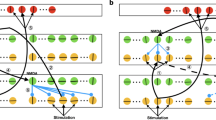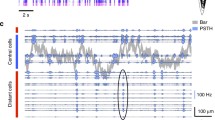Abstract
This article makes use of a push-pull shunting network, which was introduced in the companion article, to model certain properties of X and Y retinal ganglion cells. Input to the push-pull network is preprocessed by a nonlinear mechanism for temporal adaptation, which is ascribed here to photoreceptor dynamics. The complete circuit is used to show that a simple change in receptive field morphology within a single model equation can change the network's response characteristics to closely resemble those of either X or Y cells. Specifically, an increase in width of the receptive field center mechanism is sufficient to account for generation of on-off (Y-like) instead of null (X-like) responses to modulated gratings. In agreement with experimental data, the Y cell on-off response is independent of spatial phase. Also, the model accurately predicts that on-off responses can be observed in X cells for particular stimulus configurations. Taken together, the results show how the retina combines individually inadequate modules to efficiently handle the tasks required for accurate spatial and temporal visual information processing. The model is also able to clarify a number of controversial experimental findings on the nature of spatiotemporal visual processing in the retina.
Similar content being viewed by others
References
Barlow HB (1953) Summation and inhibition in the frog retina. J Physiol (London) 119:69–88
Baylor DA, Hodgkin AL, Lamb TD (1974) Reconstruction of the electrical responses of turtle cones to flashes and steps of light. J Physiol (London) 242:759–791
Boycott BB, Wässle H (1974) The morphological types of ganglion cells of the domestic cat's retina. J Physiol (London) 240:397–419
Carpenter GA, Grossberg S (1981) Adaptation and transmitter gating in vertebrate photoreceptors. J Theor Neurobiol 1:1–42
Cleland BG, Levick WR (1974) Brisk and sluggish concentrically organized ganglion cells in the cat's retina. J Physiol (London) 240:421–456
Dowling JE (1987) The retina: an approachable part of the brain. Belknap, Cambridge
Emerson RC, Korenberg MJ, Citron MC (1989) Identification of intensive nonlinearities in cascade models of visual cortex and its relation to cell classification. In: Marmarelis VZ (ed) Advanced methods of physiological system modeling. Plenum Press, New York
Enroth-Cugell C, Robson JC (1966) The contrast sensitivity of retinal ganglion cells of the cat. J Physiol (London) 197:517–552
Freed MA, Smith RG, Sterling P (1992) Computational model of the On-alpha ganglion cell receptive field based on bipolar cell circuits. Proc Natl Acad Sci USA 89:236–240
Fukuda Y, Hsiao C-F, Watanabe M, Ito H (1984) Morphological correlates of physiologically identified Y, X and W cells in the cat retina. J Neurophysiol 52:999–1013
Gaudiano P (1991) Neural network models for spatio-temporal visual processing and adaptive sensor-motor control. Unpublished Doctoral Dissertation, Boston University
Gaudiano P (1992a) A unified neural network model of spatiotemporal processing in X and Y retinal ganglion cells. I: Analytical results. Biol Cybern (this issue)
Gaudiano P (1992b) Toward a unified theory of spatiotemporal processing in the retina. In: Carpenter G, Grossberg S (eds) Neural networks for vision and image processing. MIT Press, Cambridge (in press)
Grossberg S (1968) Some physiological and biochemical consequences of psychological postulates. Proc Natl Acad Sci USA 60:758–765
Grossberg S (1969) On the production and release of chemical transmitters and related topics in cellular control. J Theor Biol 22:325–364
Grossberg S (1970) Neural pattern discrimination. J Theor Biol 27:291–337
Grossberg S (1980a) Intracellular mechanisms of adaptation and self-regulation in self-organizing networks: the role of chemical transducers. Bull Math Biol 42:365–396
Grossberg S (1980b) How does a brain build a cognitive code? Psych Rev 1:1–51
Hochstein S, Shapley RM (1976a) Quantitative analysis of retinal ganglion cell classification. J Physiol (London) 262:237–264
Hochstein S, Shapley RM (1976b) Linear and nonlinear spatial subunits in Y cat retinal ganglion cells. J Physiol (London) 262:265–284
Koch C, Poggio T, Torre V (1987) Computation in the vertebrate retina: gain enhancement, differentiation and motion discrimination. TINS 9:204–211
Kuffler SW (1953) Discharge patterns and functional organization of the mammalian retina. J Physiol (London) 16:37–68
Melkonian DS (1990) Mathematical theory of chemical synaptic transmission. Biol Cybern 62:539–548
McGuire BA, Stevens JK, Sterling P (1986) Microcircuitry of beta ganglion cells in cat retina. J Neurosci 6:907–918
Öğmen H (1991) On the mechanisms underlying directional selectivity. Neural Comput 3:333–349
Öğmen H (1992) Sensorial nonassociative learning and its implications for visual perception. In: Omidvar (ed) Progress in Neural Networks. Ablex, NJ (in press)
Öğmen H, Gagné S (1990a) Neural models for sustained and ONOFF units of insect lamina. Biol Cybern 63:51–60
Öğmen H, Gagné S (1990b) Neural network architectures for motion perception and elementary motion detection in the fly visual system. Neural Networks 3:487–505
Pugh EN Jr, Cobbs WH (1988) Visual transduction in vertebrate rods and cones: a tale of two transmitters, calcium and cyclic GMP. Vision Res 26:1613–1643
Pugh EN Jr, Lamb TD (1990) Cyclic GMP and calcium: the internal messengers of excitation and adaptation in vertebrate photoreceptors. Vision Res 30:1923–1948
Richter J, Ullman S (1983) A model for the temporal organization of X- and Y-type receptive fields in the primate retina. Biol Cybern 43:127–145
Rodieck RW (1965) Quantitative analysis of cat retinal ganglion cell response to visual stimuli. Vision Res 5:583–601
Rushton WAH (1958) Kinetics of cone pigments measured objectively on the living human fovea. Ann NY Acad Sci 74:291–304
Satio H (1983) Morphology of physiologically identified X-, Y- and W-type retinal ganglion cells of the cat. J Comp Neurol 221:279–288
Siminoff R (1991) Simulated bipolar cells in fovea of human retina. Part I. Computer simulation. Biol Cybern 64:497–504
Sperling G (1970) Model of visual adaptation and contrast detection. Percept Psychophys 8:143–157
Sterling P (1990) Retina. In: Shepherd GM (ed) The synaptic organization of the brain, 3rd edn, chap 6. Oxford University Press, New York, pp 170–213
Sterling P, Freed M, Smith RG (1987) Microcircuitry and functional architecture of the cat retina. TINS 9:186–192
Werblin F (1991) Synaptic connections, receptive fields, and patterns of activity in the tiger slamander retina. Invest Ophthalmol Vis Sci 32:459–483
Author information
Authors and Affiliations
Rights and permissions
About this article
Cite this article
Gaudiano, P. A unified neural network model of spatiotemporal processing in X and Y retinal ganglion cells. Biol. Cybern. 67, 23–34 (1992). https://doi.org/10.1007/BF00201799
Received:
Accepted:
Issue Date:
DOI: https://doi.org/10.1007/BF00201799




